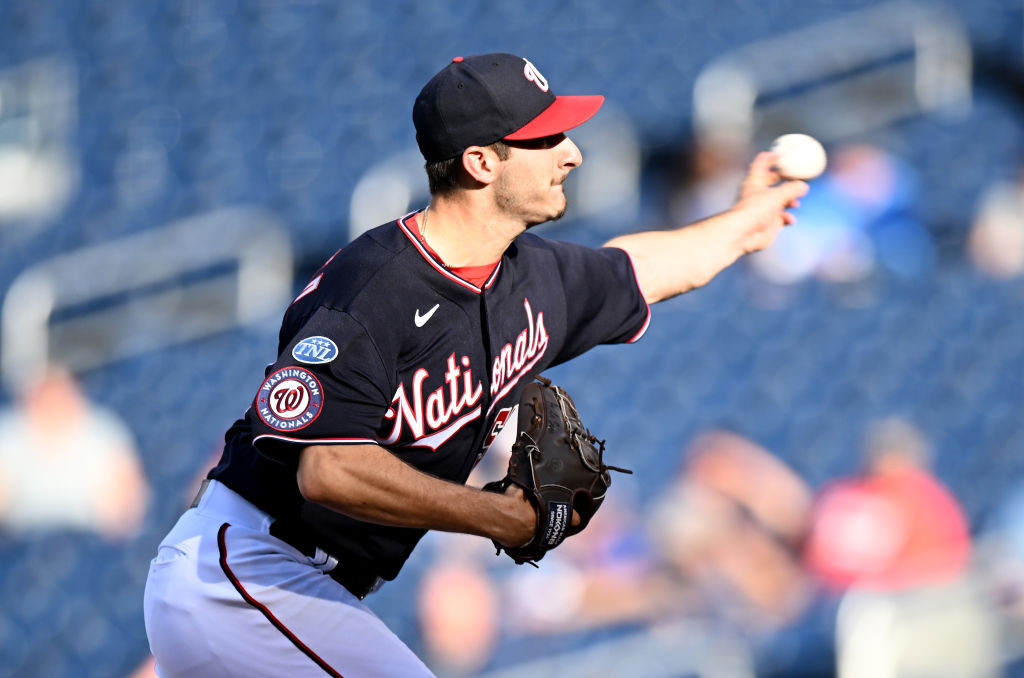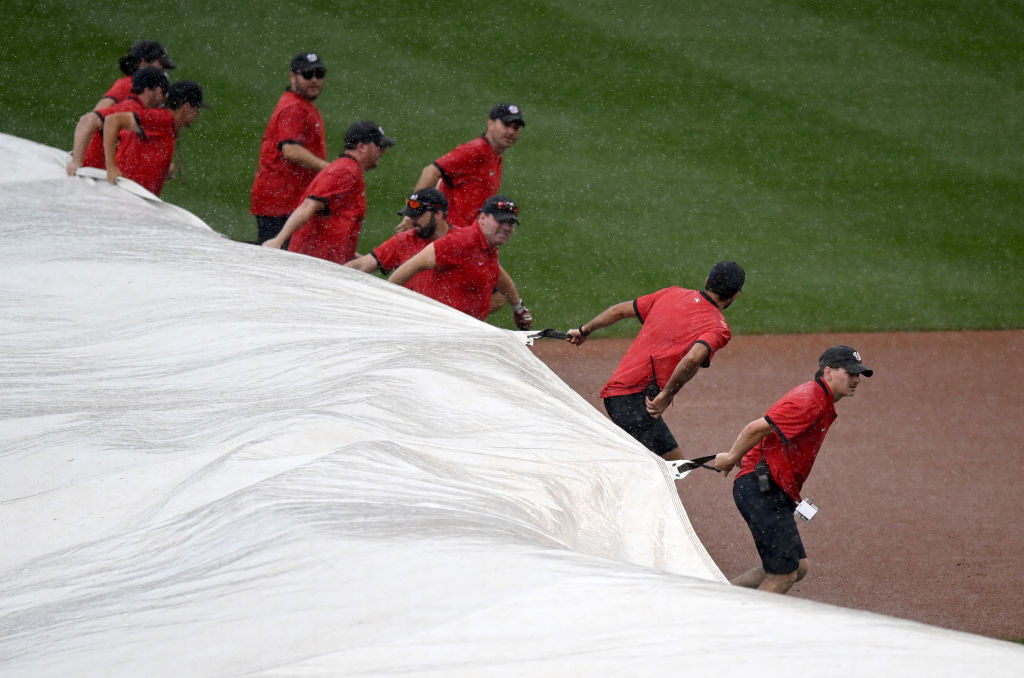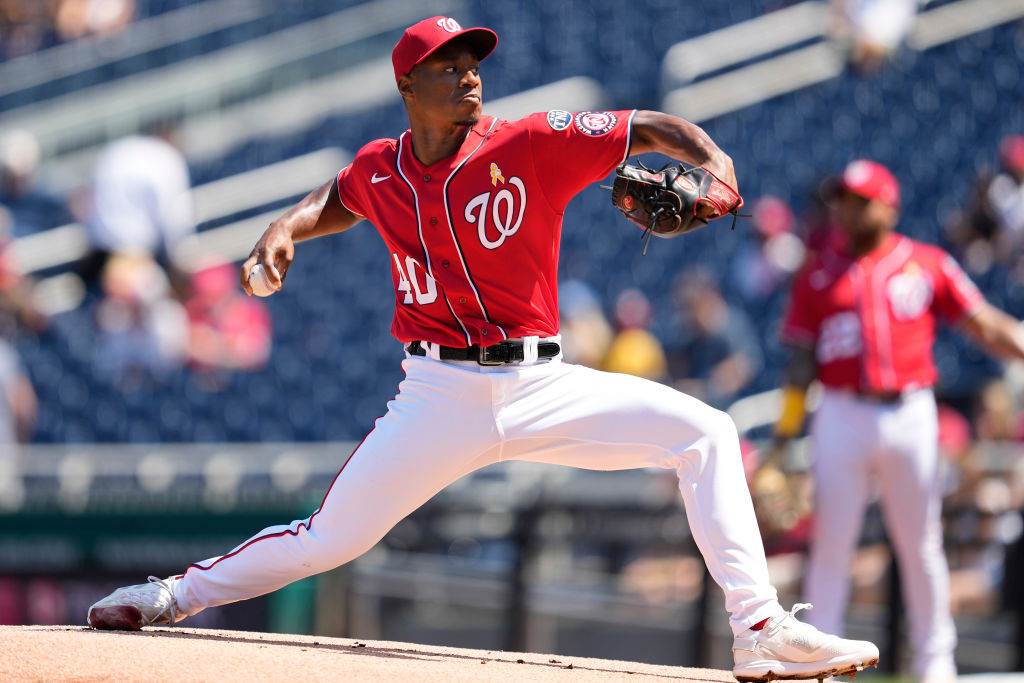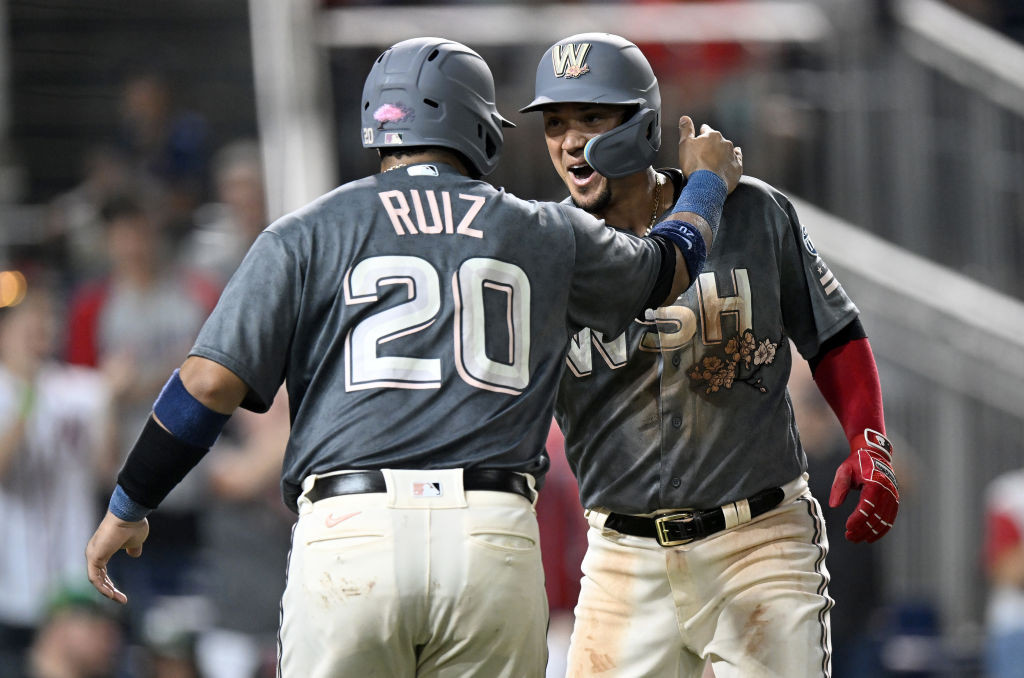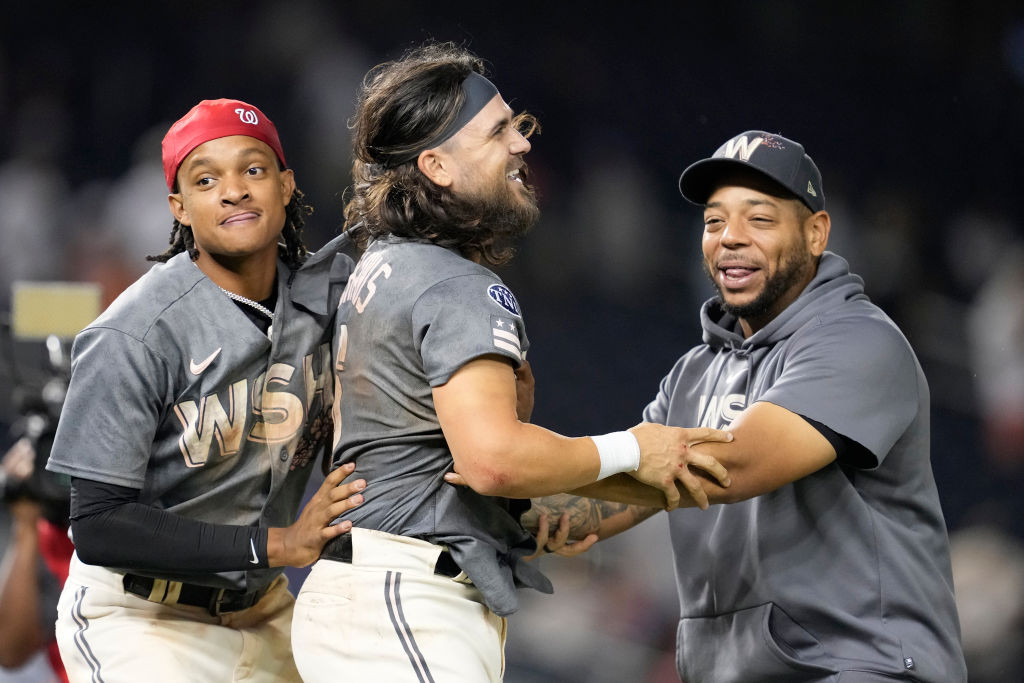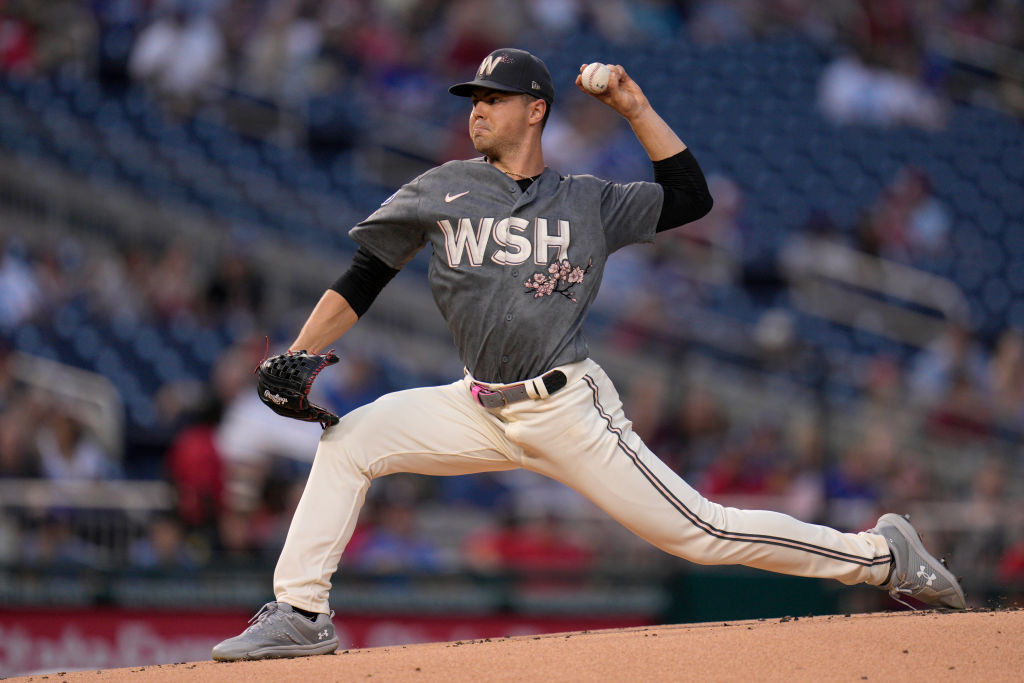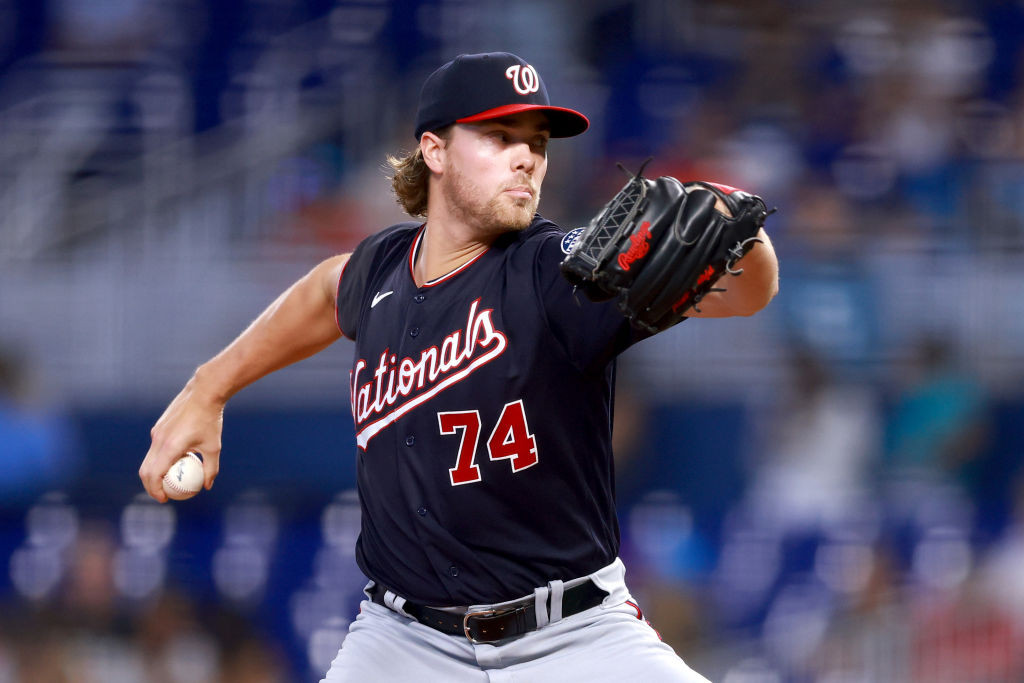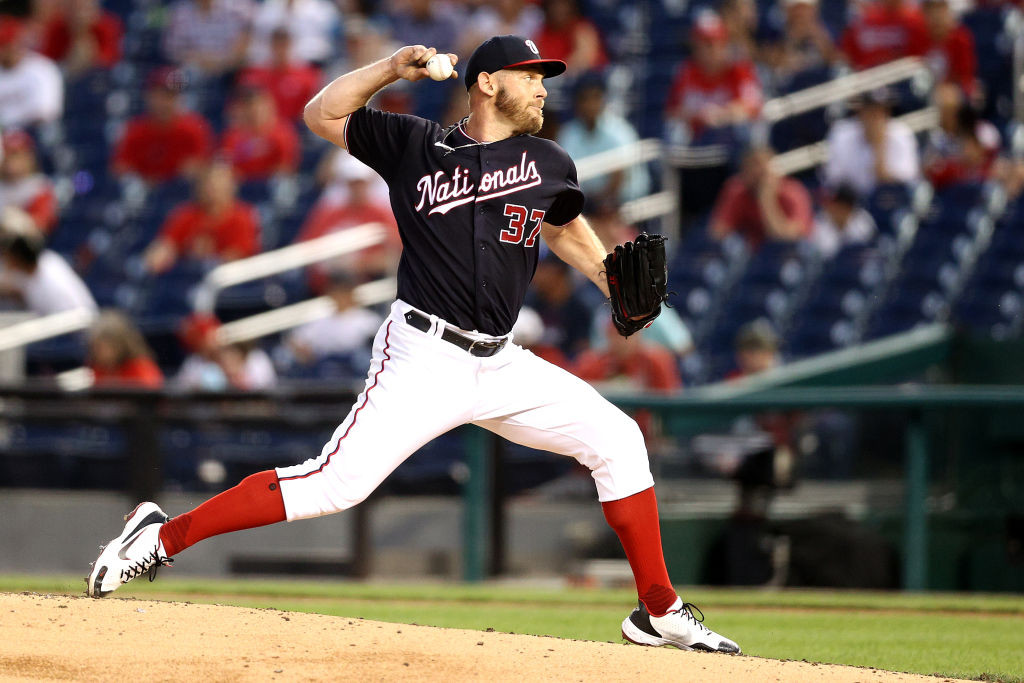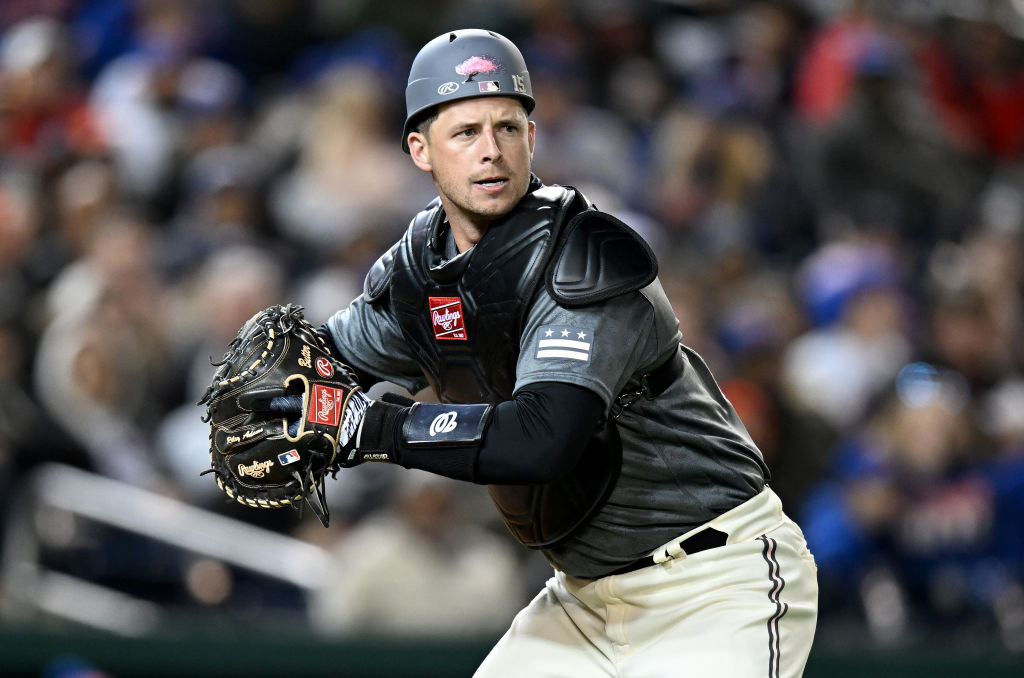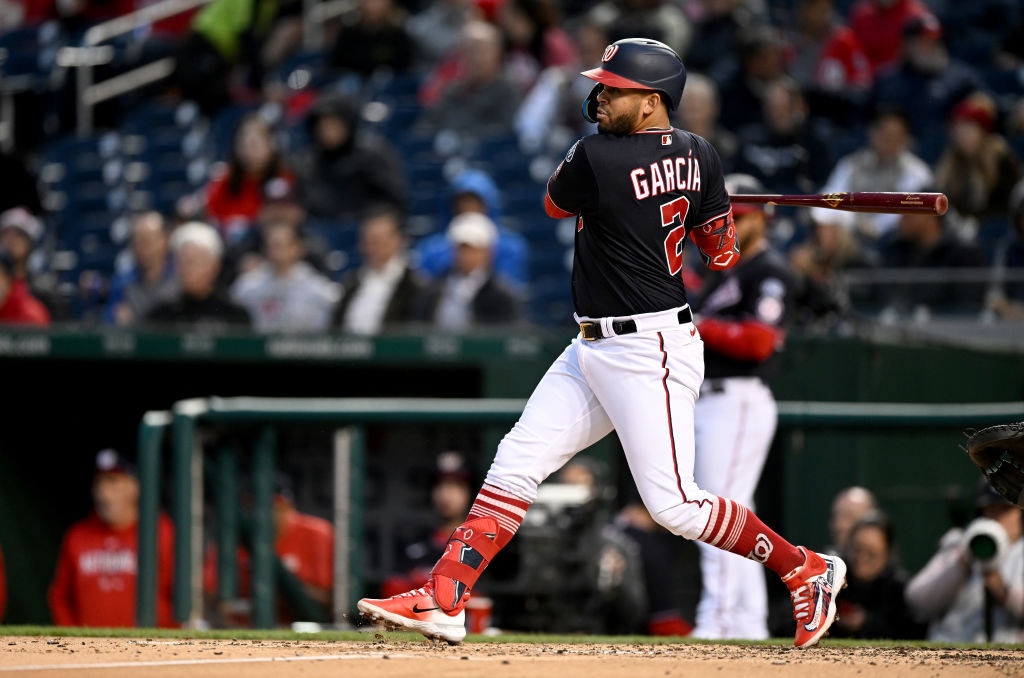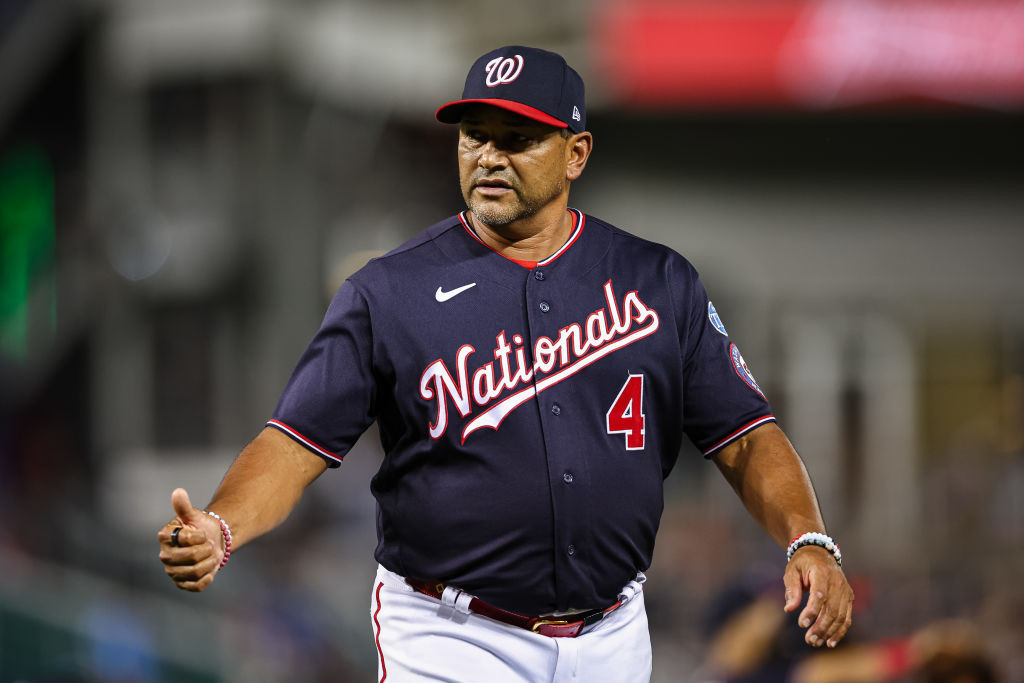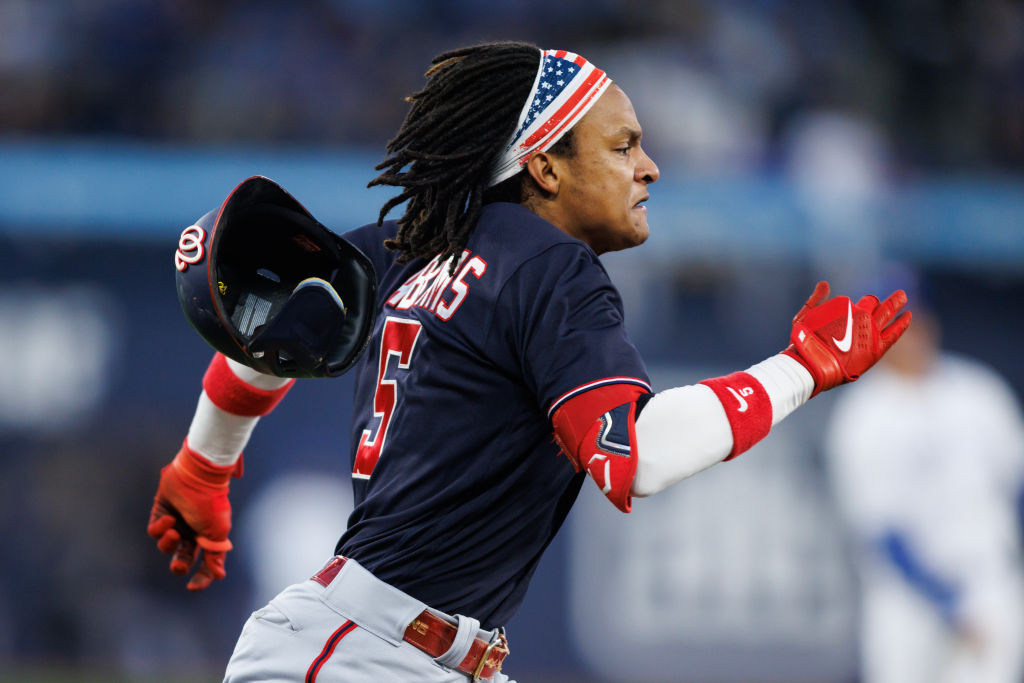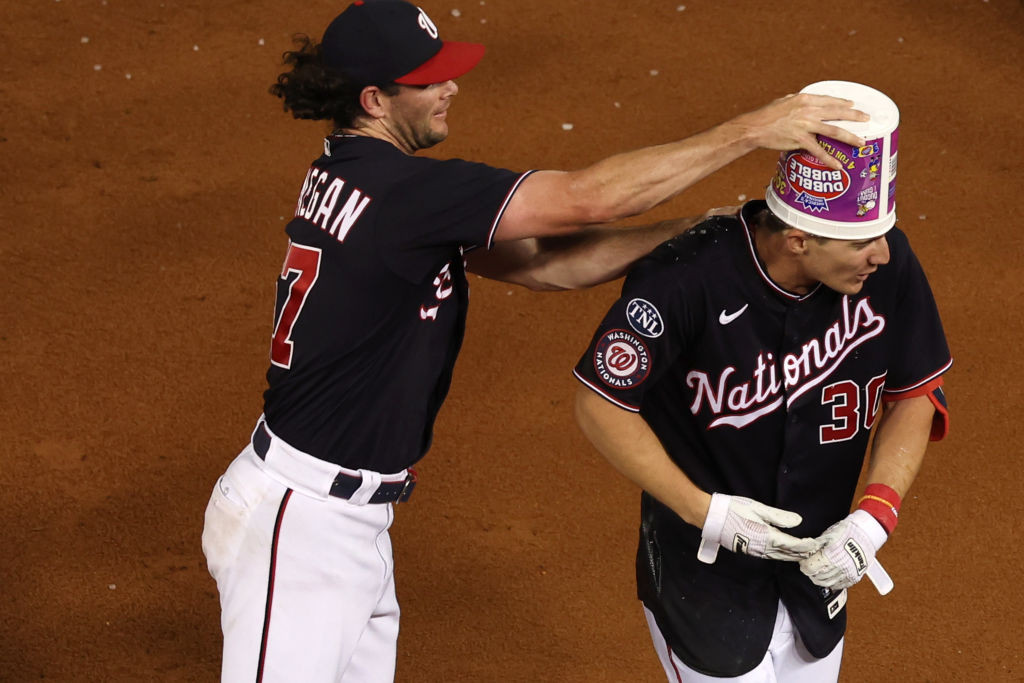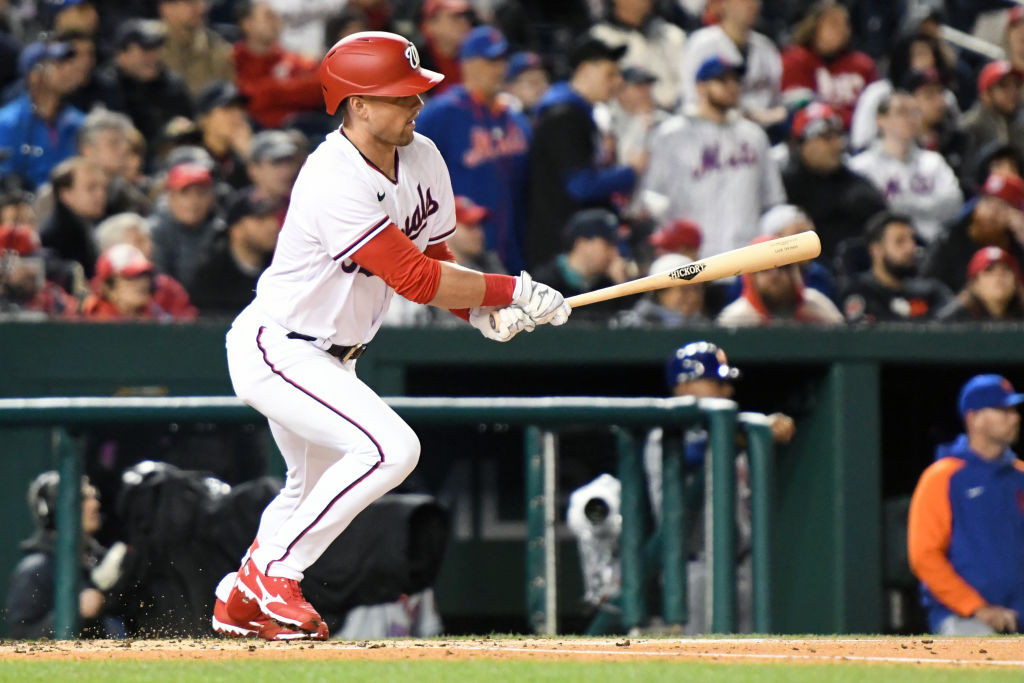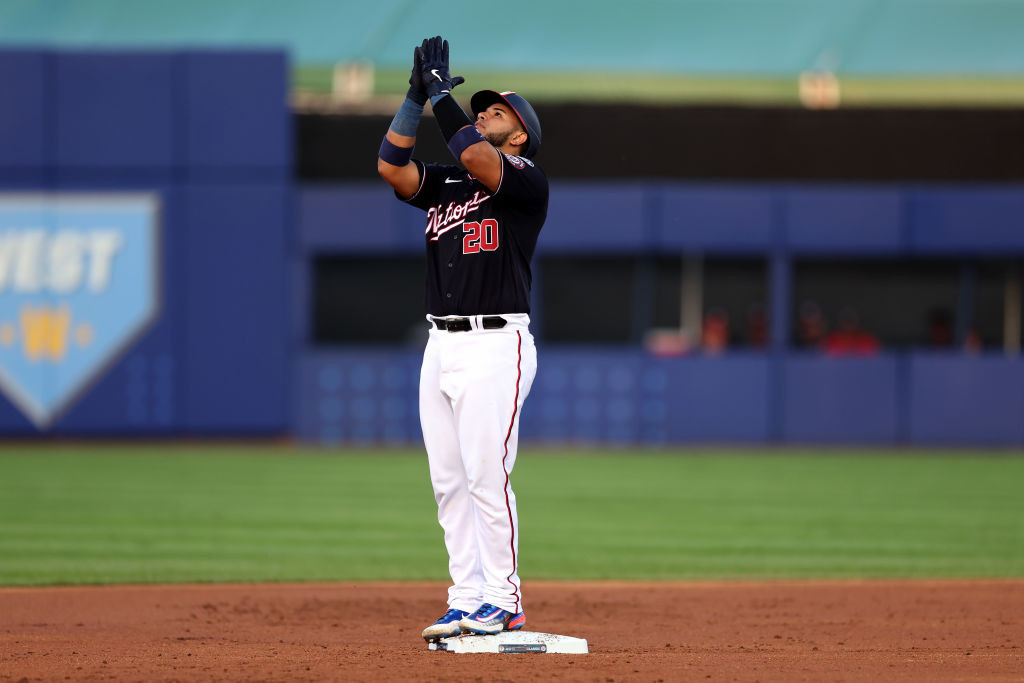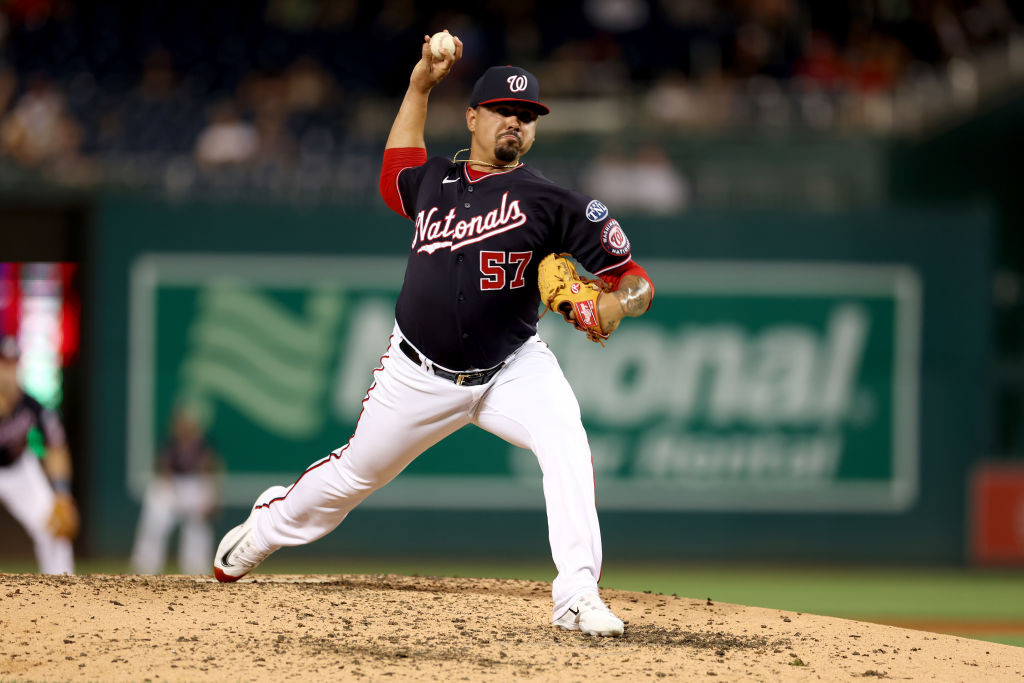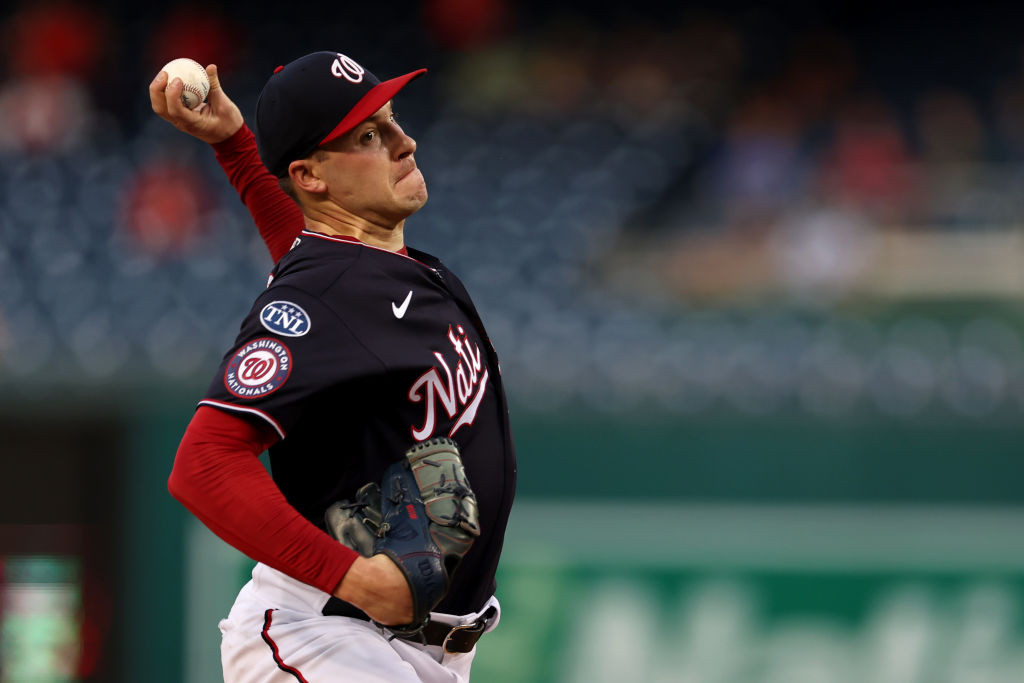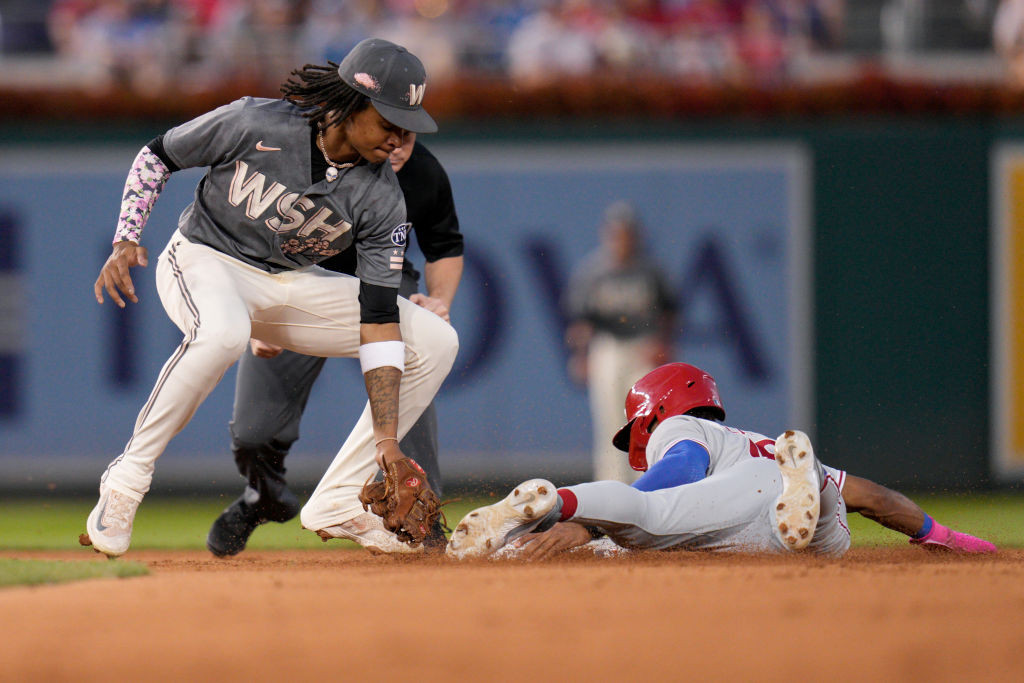Joe La Sorsa’s relief appearance Sunday wasn’t particularly memorable. It didn’t make a difference in the outcome of the game (a 7-3 loss by the Nationals against the Dodgers). It included no defining moment, no critical out recorded and no damaging hit surrendered.
But when it came time to dissect what happened on another long, rain-delayed day at the ballpark, Davey Martinez went out of his way to mention the rookie left-hander’s seemingly innocuous relief appearance.
“I give a lot of credit to Joe,” the Nationals manager said. “That was awesome. It saved our bullpen, big-time.”
Having used up pretty much every other reliever on his roster the previous two nights, Martinez’s options for Sunday’s game were thin. And when starter Trevor Williams lasted only 4 1/3 innings, the situation looked all the more dire.
Martinez went to Mason Thompson first, the right-hander facing two batters in the fifth before the game went into a 58-minute delay, then returning after that to finish the inning and return to face two batters to open the sixth. Next up was La Sorsa, who entered with a runner in scoring position but stranded him there with three quick outs.
They played a ballgame at Nationals Park this afternoon, the 143rd game of this 162-game season. For the third straight day, it included a rain delay. And for the second time this weekend, it included a loss to the Dodgers.
The finale of a long, drawn-out series ended with a dud, Trevor Williams digging the Nationals into yet another early hole en route to a 7-3 loss that never really felt within reach even though it technically was.
Those who were here for the entire weekend were treated to a grand total of 9 hours, 26 minutes of actual baseball, plus 6 hours, 42 minutes of delays. Outside of a few fun moments late Saturday night in the Nats’ 11-inning win, most of it was tough to experience in person.
The Dodgers, unsurprisingly, proved themselves to be the superior team, well on their way to a 10th division title in 11 years. The Nationals, after an uplifting stretch for much of July and August, have now lost 10 of 13 with three weeks to go in the season, two of them to be spent on the road, one of them to be spent back here.
"The long games, the extra innings ... this weekend was a grind," manager Davey Martinez said. "We didn't score many runs today, but I saw some really good things."
The Nationals will give Josiah Gray three extra days of rest before he makes his next start, hoping the time off gives the struggling right-hander a chance to catch his breath and still finish a once-promising season strong.
Gray has totaled only six innings in his last two starts, allowing seven total runs while walking eight batters and throwing 149 pitches in the process. His next turn in the rotation would have come Monday in the Nats’ series opener at the Pirates, but he now will wait until Thursday’s finale at PNC Park to take the mound.
That start will be 11 days removed from his previous outing, so this will be the equivalent of having an entire turn skipped in the rotation.
“As we all know, he’s our All-Star,” manager Davey Martinez said. “And while he’s been struggling a little bit of late, I just want to give him a little break.”
Gray was named an All-Star for the first time in his career, back when he sported a 3.00 ERA through his first 13 starts of the season. But in 14 starts since, his ERA has been a hefty 5.30, and over 69 2/3 innings he has issued 38 walks while serving up 11 homers.
Hey, you know what would be great? If the Nationals and Dodgers could play a ballgame today that starts on time and isn’t interrupted by rain at any point. Wouldn’t that be just lovely?
It’s possible that wish will come true, if the storm that’s passing through town this morning clears out in time for a 1:35 p.m. first pitch. Keep your fingers crossed.
The Nationals have a shot at a series win after Saturday night’s bonkers, 11-inning victory via a walk-off wild pitch. The bullpen is not in great shape at this point, so there really is pressure on Trevor Williams to bounce back from a bad start last time out and give his team a chance. Considering the lineup he’s facing, that’s a tall task.
The Nats have been scoring some runs this weekend, so that’s a good thing. And they’ve hit for some power, which is also a good thing. We’ll see if they can keep that up this afternoon and emerge with what would have to be considered an impressive series win over one of the best teams in baseball.
WASHINGTON NATIONALS vs. LOS ANGELES DODGERS
Where: Nationals Park
Gametime: 1:35 p.m. EDT
TV: MASN2, MLB.tv
Radio: 106.7 FM, MLB.com
Weather: Storms ending, 88 degrees, wind 7 mph out to left field
For all the attention that’s been paid to MacKenzie Gore and Josiah Gray – and for all the attention that will be paid to Cade Cavalli once he returns from Tommy John surgery – the Nationals have another young starter who has made just as compelling a case to be part of this team’s long-term plan.
In some ways, Jake Irvin’s case is even stronger than his rotation mates, if for no other reason than the immutable fact he’s been the Nats’ most consistently effective starter for months.
The fourth-round pick from the 2018 draft may have the pedigree others do, and he may not have shown up on prospect rankings the way others did, but consider the body of work he’s amassed this year: Irvin has a lower ERA than Gore, a lower WHIP than Gray and has averaged more innings per start than either.
Irvin wasn't rewarded for his efforts tonight with an individual win, but at least his Nationals teammates somehow found a way to come away with a collective win, topping the Dodgers 7-6 in 11 wacky innings to cap a long day and night on South Capitol Street.
"That's all we're looking for: For the team to take steps forward," Irvin said. "Tonight was just a grind. The defense played absolutely outstanding. It was a lot of fun to watch."
MacKenzie Gore’s season has likely to come to an end three weeks early after the Nationals placed the left-hander on the 15-day injured list with a pair of blisters on his middle finger that has impacted at least two of his recent starts.
Gore was hampered by the ailment during Friday night’s 8-5 loss to the Dodgers, in which he gave up three homers and was pulled after 89 pitches in only four innings. It was the second time this summer he had a start cut short by a blister, and it’s something that has plagued him in the past as well.
“It’s kind of always been a thing,” he said after the game. “It’s no excuse, but it’s frustrating. It is a real thing.”
Though he wouldn’t completely rule out the possibility, manager Davey Martinez made it clear it’s highly unlikely Gore will return to pitch before season’s end. He won’t be eligible to come off the IL until Sept. 24, at which point there’s only one week of games left.
“We’ll keep an eye on him, but I’d hate to start him up again,” Martinez said. “We’re getting close to the innings. Honestly, we’re beyond the innings we thought we’d get (coming into the year). But right now, I’m not going to rule anything out. Give me a few days. I want to sit down and have a conversation with him. But I think he’ll be shut down.”
After a long night that included a 3-hour, 8-minute game and a 1-hour, 34-minute rain delay, the Nationals and Dodgers are back at it this afternoon for the second game of their weekend series. The Nats have lost nine of their last 11 and sure could use a win.
They also sure could use a start longer than four, or ideally five, innings. They’ve put way too much strain on an already tired bullpen the last couple weeks, and Davey Martinez wound up using six relievers Friday night. So the pressure’s on Jake Irvin to do what he’s actually done with some regularity this season and provide length. Against a tough Dodgers lineup, that’s a stiff challenge.
Martinez does have another available reliever today in Joe La Sorsa, who was recalled from Triple-A Rochester when the Nationals placed MacKenzie Gore on the 15-day injured list with blisters on his finger. Stay tuned for more on that story.
WASHINGTON NATIONALS vs. LOS ANGELES DODGERS
Where: Nationals Park
Gametime: 4:05 p.m. EDT
TV: MASN2, MLB.tv
Radio: 106.7 FM, MLB.com
Weather: Chance of storms, 88 degrees, wind 7 mph out to left field
NATIONALS
SS CJ Abrams
DH Lane Thomas
1B Dominic Smith
C Keibert Ruiz
RF Travis Blankenhorn
LF Jake Alu
3B Ildemaro Vargas
2B Luis García
CF Jacob Young
The statement was released at 5:41 p.m. Friday, roughly 90 minutes before first pitch at Nationals Park, attributed to Mark Lerner and pertaining to one of the most important players in club history.
“Stephen Strasburg is and always will be an important part of the Washington Nationals franchise,” it read. “We support him in any decision he makes and will ensure that he receives what is due to him.
“It is regrettable that private discussions have been made public through anonymous sources attempting to negotiate through the media. While we have been following the process required by the collective bargaining agreement, behind-the-scenes preparations for a press conference had begun internally. However, no such event was ever confirmed by the team or promoted publicly. It is unfortunate that external leaks in the press have mischaracterized these events.”
A rare public pronouncement from the Nats’ managing principal owner, but an understandable one given the confusion over what was supposed to be a formal press conference to announce Strasburg’s retirement later today.
But then came the final two lines of the three-paragraph statement, which Lerner closed with an unexpected bang: “It is our hope that ongoing conversations remain private out of respect for the individuals involved. Until then, we look forward to seeing Stephen when we report to spring training.”
The Nationals’ September swoon has largely been tied to poor performances by their starting pitchers, and in particular by abbreviated outings by those starters.
Unable to consistently complete five or more innings, members of the Nats rotation have not only dug their team into early holes, they’ve put added strain on a bullpen that’s not built to withstand this much work.
So the last thing anyone wanted to see tonight in the opener of a weekend series against the Dodgers, the first of 17 consecutive scheduled games heading into the season’s final week, was another short outing by MacKenzie Gore. The left-hander lasted only four innings, and even though he technically kept his team in the game, the work that was then required of the bullpen was too much to overcome in what finished as an 8-5, rain-delayed loss to Los Angeles.
Not even the thunderstorm that popped up with two outs in the top of the seventh could salvage anything for the Nats. The rain didn't last long enough for officials to call the game at that point, so Davey Martinez had to ask Amos Willingham (his sixth reliever of the night) to pitch the final 2 1/3 innings following a 1-hour, 34-minute delay.
In the end, Martinez summoned all but two of his eight bullpen arms. Willingham was the only one who recorded three outs. Two were charged with two runs a piece: Robert Garcia and Jordan Weems, who combined to allow the decisive four runs in the top of the sixth of a game that saw Nationals pitchers issue nine total walks.
Riley Adams wasn’t overly concerned in the moment when he fouled off a pitch Wednesday night and felt something wrong with his left wrist. That’s not uncommon. Then he tried to take a practice swing.
“I went to grab the bat again, and it certainly felt more painful than I’ve experienced before,” the Nationals catcher said. “That’s when I was thinking something was up.”
Sure enough, Adams learned Thursday he had fractured the hamate bone in his wrist, an injury that will require surgery Monday and will end his season 3 1/2 weeks before he wanted. The Nats placed him on the 10-day injured list today and recalled second baseman Luis García from Triple-A Rochester to take his roster spot.
It’s a tough, and abrupt, end to a promising season for Adams. The 27-year-old finished with 159 plate appearances over 48 games as Keibert Ruiz’s backup behind the plate, hitting .273 with 13 doubles, two triples, four homers, 21 RBIs and an .807 OPS.
Hamate fractures, while frustrating, typically heal in six to eight weeks. That affords Adams plenty of time to recover and begin his offseason training program with no ill effects, though hitters have been known to need more time to see their power return once back playing on a daily basis.
It was an eventful off-day for the Nationals, who have made a roster move heading into tonight’s series opener against the Dodgers. Riley Adams unfortunately did break the hamate bone in his left wrist on Wednesday night, so he’s on the 10-day injured list and out for the rest of the season. Taking his place on the roster is Luis García, who was recalled from Triple-A Rochester and will get another shot to prove he has made adjustments since his demotion last month.
García is right back in the lineup, batting eighth and starting at second base. Keibert Ruiz is catching, but I would imagine we’re going to see more of Drew Millas down the stretch now that Adams is out. Lane Thomas also is out for the third straight game, his back still not fully healed. Thomas said the other day he expected to return “Friday or Saturday,” so he still has a chance to make good on that.
MacKenzie Gore, meanwhile, returns after going on bereavement leave and will be making his first start in 10 days. The left-hander looked like he needed a breather after that last outing in Toronto, so we’ll see if the extra rest did him any good. It’s not an easy challenge for him, facing a tough Dodgers lineup tonight.
WASHINGTON NATIONALS vs. LOS ANGELES DODGERS
Where: Nationals Park
Gametime: 7:05 p.m. EDT
TV: MASN2, MLB.tv
Radio: 106.7 FM, MLB.com
Weather: Chance of storms, 87 degrees, wind 8 mph out to left field
NATIONALS
SS CJ Abrams
DH Joey Meneses
1B Dominic Smith
C Keibert Ruiz
RF Travis Blankenhorn
LF Jake Alu
3B Carter Kieboom
2B Luis García
CF Jacob Young
After their most grueling stretch of the season, the Nationals suddenly have had two days off this week. It made for a nice respite at a time when most everyone needed it. But now they begin another tough stretch tonight, with 17 consecutive game days on the schedule until they get another break heading into the final week of the season.
So much has happened since the All-Star break, much of it positive, some of it negative. There are matters to discuss on the field, as well as off the field right now.
Let's take this opportunity to address all of it. Submit your questions in the comments section below, then check back throughout the morning for my responses ...
He had already reached base earlier in the game and immediately swiped second. So when CJ Abrams singled home the tying run in the bottom of the seventh Wednesday night, was there ever any question what he would do next?
“I get on base, and I’m trying to take that extra 90 every time I can,” the Nationals shortstop said. “Get in scoring position for my teammates, help the team win.”
Abrams’ baserunning wasn’t really the difference in the Nats’ 3-2 win over the Mets. His RBI single in the seventh was. As was Jacob Young’s walk-off single in the ninth, with Abrams watching from the on-deck circle and ready to take a crack at it himself if his rookie teammate hadn’t delivered.
But it was a milestone night for Abrams on the bases nonetheless, because he reached the 40-steal mark for the first time in his career and joined an exclusive list of Nationals who have ever done that.
Only Trea Turner (who stole 46 bases in 2017, then 43 in 2018) and Alfonso Soriano (41 in 2006) have stolen more bases in a single season for the Nats than Abrams, who still has 22 more games to go and a real shot at establishing a new club record.
The Nationals’ six-week surge this summer was keyed in large part by their ability to win the late innings of games, both at the plate and on the mound. Their more recent six-game slide has seen them lose games late on multiple occasions, reversing the trend.
So wouldn’t you know they finally snapped the losing streak by storming back to beat the Mets in walk-off fashion?
The fact one of their recent young call-ups delivered it only made this 3-2 win sweeter: Jacob Young’s chopper up the middle past a drawn-in infield scored Carter Kieboom from third and gave the Nats an opportunity to celebrate for the first time in a week.
"Right when I hit it, I kind of saw where I hit it, and it was a good spot," said the 24-year-old outfielder who opened the season at Single-A Wilmington and was promoted three times to reach the majors two weeks ago. "It felt great to look at the dugout, and everyone was already coming out. It's a great feeling to have all your boys running out at you."
On a record-setting September evening in the District – first-pitch temperature was 97 degrees, hottest for a game at Nationals Park since July 2012 – the Nats dug themselves into an early hole and went silent at the plate for six innings before finally waking up late.
Lane Thomas is out of the Nationals lineup for the second straight night after receiving an injection in his back, but the outfielder expects to be back playing this weekend.
Thomas was encouraged by results of the MRI he received Tuesday, saying it did not show any injury of significance.
“Just a little inflammation in a few areas,” he said. “Got an injection. You just can’t do anything for 48 hours after that, so I should be good for Friday or maybe Saturday.”
Thomas admitted his back had been a minor issue for a while, but it flared up on him while making a throw one week ago in Toronto. He was held out of the lineup the following night but returned to play the rest of the weekend against the Marlins and wound up homering three straight days.
When the back was still bothering him after all that, Thomas was sent for Tuesday’s MRI and missed the Nationals’ series opener against the Mets.
The Nationals need to win a game. Doesn’t matter how. Doesn’t matter who does it. They just need to win a game for the first time in eight days.
They can get there with a quality pitching performance from Joan Adon, who has offered up a couple of those in five starts since returning to the big leagues last month: once against the Reds, once against the Marlins. This is the first time Adon has faced the Mets this year after two matchups last year in which he allowed seven runs in eight total innings.
The Nats were going to face Carlos Carrasco tonight, but the veteran right-hander is out for the season after a 50-pound barbell fell on his pinky finger and broke it. So instead the Mets send right-hander José Butto to the mound for only his fourth career start. One of those came against the Nationals back on April 25, when he issued six walks in 4 2/3 innings and took the loss.
WASHINGTON NATIONALS vs. NEW YORK METS
Where: Nationals Park
Gametime: 7:05 p.m. EDT
TV: MASN, MLB.tv
Radio: 106.7 FM, MLB.com
Weather: Clear, 92 degrees, wind 5 mph out to left field
NATIONALS
SS CJ Abrams
DH Joey Meneses
C Keibert Ruiz
LF Travis Blankenhorn
1B Dominic Smith
3B Carter Kieboom
2B Jake Alu
RF Alex Call
CF Jacob Young
For 94 consecutive games, Davey Martinez filled out a lineup that featured one of two names in the leadoff position: Lane Thomas or CJ Abrams. Since mid-May, there hadn’t been any reason for the Nationals manager to consider anyone else for that job.
But when both Thomas and Abrams needed the night off Tuesday, Martinez was left to select another name for one of the most prominent roles on the team. He chose Jacob Young, knowing the rookie had led off all year in the minors, not to mention throughout the majority of his baseball life.
And though there wasn’t much positive to take away from an 11-5 loss to the Mets, the young leadoff man’s performance did qualify.
Young wound up going 2-for-4 with a walk, an RBI, a double and two runs scored, showing off both his bat and his legs in a solid all-around game.
“He got ready a little earlier tonight, looking for balls in the strike zone,” Martinez said. “He laid off some really good pitches. I’ve known that about him. He’s really good about that, and he’s been leading off his whole career. We’ll see, if Lane can’t play tomorrow, we might let him lead off again.”
Precisely one week ago, Davey Martinez sat in his office at Rogers Centre and raved about the Nationals’ performance in a tense win over the Blue Jays, the latest in a string of impressive wins for this fast-improving ballclub.
"It was awesome for them to feel that adrenaline," the manager said that night. "That was a playoff game. That's what it felt like. Fans were into it. You had a good team on the other side there. The boys stepped up and played well. You can't ask for more than what they did today."
Oh, how long ago that feels now.
The Nationals team that was blown out 11-5 by the Mets tonight looked like it felt no adrenaline. It gave the crowd little reason to provide them with any extra energy. It spent two hours going through the motions of a lopsided game before putting up a bit of a fight late that nonetheless resulted in a sixth consecutive loss, further distancing itself from what felt like such an encouraging stretch of success just before it all came crashing down.
"Look, after the seventh inning, we're pretty good at scoring runs," Martinez said. "But we've got to get some runs early in the game. Especially when you're already down 4-0. To me, that's the big key. When you're in these games and all of a sudden you go down in the first inning, it sucks the air out of you. You're playing comeback. We've got to get through those first couple innings, score some runs early and often and then go from there."
CJ Abrams has missed only 12 games this season. Lane Thomas has missed only five. Tonight, the Nationals will be without both stalwarts for the first time in 2023.
Davey Martinez’s lineup card for the series opener against the Mets doesn’t look like any previous one he has submitted this season. Rookie Jacob Young is leading off, with Joey Meneses batting second, Keibert Ruiz slotted third and Riley Adams hitting cleanup for the first time in his career.
Such is the byproduct of a lineup missing the team’s usual No. 1 and No. 2 hitter.
Abrams’ day off was scheduled, according to Martinez, who noted how the 22-year-old shortstop has looked worn down in the last week as a tough schedule and the reality of September baseball converged.
“The way he plays the game, he’s constantly using his legs,” Martinez said. “He plays a premium position. He’s constantly running, on his feet, stealing bases. He’s been doing a lot of things, diving everywhere. I just felt like over the last few days – and the fact it’s going to be so hot – having a day off yesterday and a day off today could reset him a little bit.”
The Nationals don’t have to face the Marlins anymore this season, and if that isn’t cause for celebration, what is? Tonight they open a two-game series with the Mets, the last time they’ll face New York this year. A sweep would give the Nats the season series at 7-6; one loss would give it to the Mets (if you care about such things).
This would’ve been MacKenzie Gore’s turn in the rotation, but the Nationals are giving the left-hander time to get himself ready after returning today from bereavement leave. (Joe La Sorsa was optioned to Triple-A Rochester.) So it’s Patrick Corbin on the mound, well rested himself because his last start came Wednesday in Toronto.
The Nats face a very different Mets rotation from the last one they faced, with Max Scherzer and Justin Verlander now due to pitch against each other Wednesday night in a huge showdown between the Rangers and Astros. It’ll be Jose Quintana for New York tonight; the veteran lefty has not faced the Nationals yet during an injury-plagued season.
WASHINGTON NATIONALS vs. NEW YORK METS
Where: Nationals Park
Gametime: 7:05 p.m. EDT
TV: MASN, MLB.tv
Radio: 106.7 FM, MLB.com
Weather: Partly cloudy, 92 degrees, wind 6 mph in from center field
NATIONALS
CF Jacob Young
1B Joey Meneses
C Keibert Ruiz
DH Riley Adams
3B Carter Kieboom
SS Ildemaro Vargas
LF Travis Blankenhorn
RF Alex Call
2B Jake Alu




-1745819772711.png)
